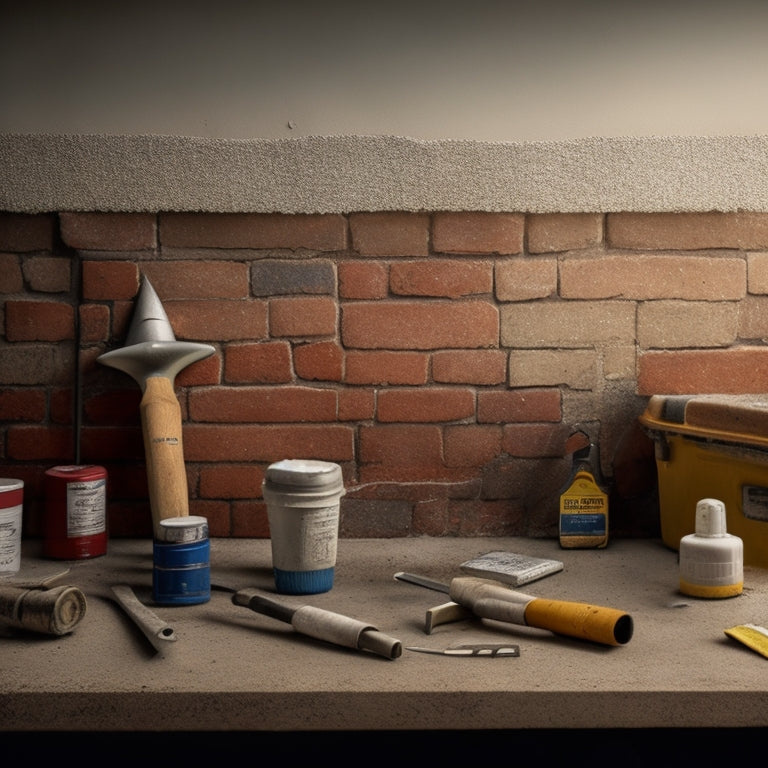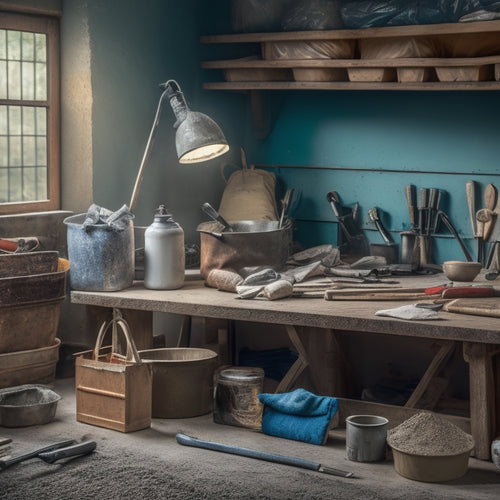
7 Best Repair Tools for Concrete Block Walls
Share
You'll need a range of specialized tools to tackle concrete block wall repairs effectively. A high-quality trowel is essential for holding and spreading mortar, while a concrete block chisel set is necessary for demolishing old mortar or debris. A heavy-duty mixing bucket is required for combining mortar or concrete, and a block filling grout gun simplifies filling gaps and voids. Additionally, a cinder block joint scraper, repair epoxy injection kit, and masonry brush for sealing are all vital for a successful repair. With these seven tools in your arsenal, you'll be well-equipped to tackle even the most complex repairs - and by exploring each tool's capabilities, you'll reveal the secrets to a long-lasting fix.
Key Takeaways
• A high-quality, square-notched trowel is essential for holding and spreading the right amount of mortar for cinder block walls.
• A sturdy chisel set is necessary for demolishing old mortar or debris, and regular cleaning and inspection prevent rust and damage.
• A heavy-duty mixing bucket is required for combining mortar or concrete, and size selection should match project requirements for efficiency.
• A block filling grout gun is ideal for filling gaps and voids, offering precise control over grout dispensation and minimizing waste.
• A cinder block joint scraper is necessary for removing old mortar from joints, and adjustable blades offer customization for different joint sizes.
Essential Trowel for Cinder Blocks
You'll need a high-quality, square-notched trowel to properly apply and finish mortar when repairing or building cinder block walls. This type of trowel is ideal for holding and spreading the right amount of mortar, guaranteeing a strong bond between the blocks. When selecting a trowel, you'll come across different types, including pointed, rounded, and square-notched. For cinder block walls, a square-notched trowel is the best choice.
Proper trowel maintenance is essential to extend its lifespan and guarantee peak performance. After each use, clean the trowel thoroughly with a wire brush to remove any mortar residue. Regularly apply a rust-resistant coating to prevent corrosion. Store the trowel in a dry place, away from direct sunlight.
You should also inspect the trowel's notch edges regularly, sharpening them as needed to maintain their effectiveness. By choosing the right trowel type and following proper maintenance procedures, you'll be able to achieve professional-looking results and guarantee the longevity of your cinder block walls.
Concrete Block Chisel Set
Demolishing and removing old mortar or debris from concrete block walls requires a sturdy concrete block chisel set, designed to withstand the rigors of heavy-duty demolition work. When selecting a chisel set, consider the block chisel materials, such as high-carbon steel or tungsten carbide, which provide durability and resistance to wear.
To get the most out of your chisel set, follow these chisel maintenance tips:
-
Regularly clean and inspect your chisels to prevent rust and damage
-
Store chisels in a dry place, away from direct sunlight and moisture
-
Sharpen chisels regularly to maintain their effectiveness
-
Use the correct chisel angle to avoid damaging the surrounding concrete
-
Wear protective gear, including gloves and safety glasses, when operating chisels
Heavy-Duty Mixing Bucket
When preparing a new batch of mortar or concrete, a heavy-duty mixing bucket is essential for efficiently combining and blending the ingredients.
You'll want a bucket that can withstand the rigors of mixing and handling heavy materials. Look for buckets made from durable, heavy-gauge steel or high-density polyethylene (HDPE) that can resist scratches and cracks.
The right mixing bucket will also help you master various mixing techniques, such as the 'flip-and-fold' method or the 'circular-motion' method. A bucket with a non-slip handle and a comfortable grip will reduce fatigue and improve control, allowing you to focus on achieving the perfect mix.
When selecting a heavy-duty mixing bucket, consider the size and capacity you need for your project. A larger bucket may be necessary for bigger jobs, while a smaller bucket may be more suitable for smaller repairs.
Regardless of size, make sure the bucket is easy to clean and resistant to corrosion. With the right heavy-duty mixing bucket, you'll be able to mix and apply your concrete or mortar with confidence and precision.
Block Filling Grout Gun
A block filling grout gun is an essential tool for efficiently filling gaps and voids in concrete block walls, allowing you to inject grout precisely where it's needed. This tool is designed to make your block wall maintenance tasks easier and more effective. With a grout gun, you can master various grout application techniques, ensuring a strong and durable bond between the blocks.
Here are some key benefits of using a block filling grout gun:
-
Easy to use: Simply load the gun with grout, aim, and squeeze the trigger to fill the gap.
-
Precise control: You can control the amount of grout dispensed, reducing waste and mess.
-
Faster application: Fill gaps quickly and efficiently, saving you time and effort.
-
Improved bonding: The grout is injected directly into the gap, ensuring a strong bond between the blocks.
-
Reduced cleanup: The gun contains the grout, minimizing mess and cleanup.
Cinder Block Joint Scraper
You'll need a reliable cinder block joint scraper to remove old, deteriorated mortar from the joints, allowing for a clean surface to reapply new mortar. This tool is essential for effective cinder block maintenance, as it enables you to remove loose debris and crumbling mortar that can compromise the structural integrity of your walls.
A good joint scraper should have a sturdy handle and a durable, rust-resistant blade that can withstand the rigors of repeated use. When selecting a joint scraper, look for one with adjustable blades that can be tailored to fit different joint sizes. This will guarantee a precise fit and prevent damage to surrounding blocks.
Repair Epoxy Injection Kit
Cracks in concrete block walls can be effectively sealed with a repair epoxy injection kit, which fills voids and strengthens the structure by bonding loose fragments together. This kit is an essential tool for structural repair methods, providing a reliable solution for repairing cracks and restoring the wall's integrity.
When using an epoxy injection kit, you'll need to follow proper epoxy application techniques to guarantee a successful repair.
Here are some key considerations to keep in mind:
-
Surface preparation: Clean and prepare the crack surface to guarantee a strong bond between the epoxy and the concrete.
-
Epoxy selection: Choose an epoxy specifically designed for concrete repair, considering factors like viscosity, pot life, and curing time.
-
Injection techniques: Use the correct injection technique, such as low-pressure injection or gravity feeding, to fill the crack completely.
-
Clamping and pressure: Apply clamping or pressure to guarantee the epoxy flows into the crack and bonds properly.
-
Curing and testing: Allow the epoxy to cure according to the manufacturer's instructions and test the repair to guarantee its integrity.
Masonry Brush for Sealing
For a durable seal, use a high-quality masonry brush to apply sealants or coatings to the concrete block wall, guaranteeing a uniform layer that effectively protects the surface from water ingress and damage.
When selecting a masonry brush, consider the bristle type, size, and material to ascertain it's suitable for your specific sealing task. Natural bristles, for instance, are ideal for applying solvent-based sealers, while synthetic bristles work well with water-based coatings.
To achieve a professional finish, master masonry brush techniques, such as working in sections, applying even pressure, and using long, smooth strokes to spread the sealant or coating. Pay attention to the brush's angle, as this affects the amount of material applied to the surface.
For sealing block surfaces, use a brush with stiffer bristles to reach into the block's cavities and corners. By following these guidelines and using the right masonry brush, you'll be able to apply a consistent, watertight seal that protects your concrete block wall from the elements and extends its lifespan.
Frequently Asked Questions
Can I Use Regular Mortar for Concrete Block Wall Repairs?
When you're repairing a concrete block wall, you might wonder if regular mortar is sufficient. The answer is, it depends.
You'll need to choose a mortar type that matches the original, considering factors like compressive strength and color. If the damage is minor, a Type S or N mortar might work.
But for more extensive repairs, you may require a specialized epoxy-based mortar. Proper repair techniques, like cleaning the area and applying the right amount of pressure, are also essential for a successful fix.
How Do I Clean Excess Grout From Block Surfaces?
When tackling grout removal from block surfaces, you'll need to employ effective techniques.
Start by using a grout saw or an old chisel to scrape off excess grout, taking care not to scratch the block.
Next, switch to a wire brush or a scrub brush to scrub the area, removing any remaining grout residue.
Do I Need to Prime the Wall Before Applying Epoxy Injection?
You're about to apply epoxy injection, but do you need to prime the wall first? Yes, you do.
Proper wall preparation is essential for a strong bond. Failing to prime can lead to uneven epoxy curing, reducing the repair's effectiveness.
Clean the surface, remove any dirt or oils, and apply a suitable primer to guarantee a solid foundation for the epoxy injection.
This step is critical for a successful repair.
Can I Use a Putty Knife Instead of a Joint Scraper?
You're wondering if you can use a putty knife instead of a joint scraper. While a putty knife can work in a pinch, it's not the ideal choice.
The advantages of a putty knife lie in its flexibility and smooth application, but it may not provide the necessary precision for scraping joints.
Consider joint scraper alternatives like a 5-in-1 tool or a scraper with adjustable blades for more effective results.
Will These Tools Work for Repairing Brick Walls as Well?
When you're tackling brick wall repairs, you'll find that the tools you use can make all the difference.
While the techniques you'll employ might differ from those for concrete block walls, the good news is that many of the same tools can be used for brick wall repair techniques.
You'll still need to scrape out old mortar, clean joints, and repoint with new material.
Conclusion
You've got the right tools to tackle that concrete block wall repair job. With these essentials, you'll be able to restore your wall to its former strength and appearance.
Did you know that according to the National Ready Mixed Concrete Association, concrete is the most widely used construction material in the world, with over 20 billion tons produced annually?
With the right tools and a little know-how, you can be a part of that statistic, creating strong and durable structures that will stand the test of time.
Related Posts
-

What Tools Do I Need for Concrete Wall Repair
As you prepare for a concrete wall repair job, you'll need a variety of tools to guarantee a successful outcome. Star...
-

Essential Power Tools for DIY Concrete Sculpting
As you begin DIY concrete sculpting, you'll need a strategic selection of power tools to achieve professional-grade r...
-

10 Must-Have Tools for Small Concrete Projects
When tackling small concrete projects, you'll need a range of essential tools to achieve professional-grade results. ...


